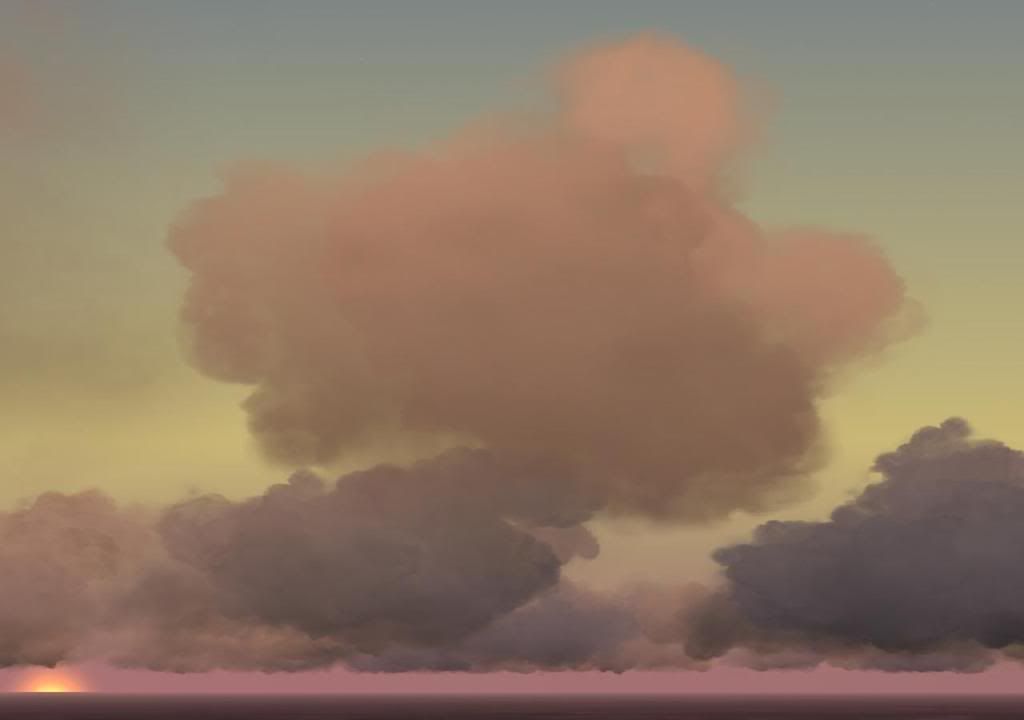
The windy country of the clouds …
— Christopher Marlowe, Dido, Queen of Carthage
One of the few remaining pleasures of air travel is meeting the clouds. I'll even select a window seat on a short flight, just to get a better look. What was, a few minutes before, a symbol of the ethereal and unreachable now seems to draw us up like dew as the airplane climbs. Now we enter the clouds, they surround us, shake us in our seats, envelop us in semi-darkness.
We've climbed through, the air's ceiling is now its floor. Outside the window, seemingly close enough to touch, knowing no laws except those of physics, are those vapor sculptures rippling and curling, sending up tentacles as though to shake hands or wave us good-bye as we leave them below.

We've climbed through, the air's ceiling is now its floor. Outside the window, seemingly close enough to touch, knowing no laws except those of physics, are those vapor sculptures rippling and curling, sending up tentacles as though to shake hands or wave us good-bye as we leave them below.

I have noticed that even people who exalt the drama of untamed land and gush over flowers can seem curiously blind to the fantastical beauty of clouds. They were treated perfunctorily in painting while Renaissance artists lavished their attention on the intricacies of flora; only with the advent of the 17th century Dutch landscapists, especially the greatest, Jacob van Ruisdael, did they begin to get their due. With the end of the Romantic era, clouds again became personae non grata (gratae? I have small Latin and less Greek) in art.
John Ruskin was typically sensitive, and typically purple prose–struck, when he wrote (quoted on the web site of The Cloud Appreciation Society):
John Ruskin was typically sensitive, and typically purple prose–struck, when he wrote (quoted on the web site of The Cloud Appreciation Society):
It is a strange thing how little in general people know about the sky. It is the part of all creation in which nature has done more for the sake of pleasing man, more, for the sole and evident purpose of talking to him and teaching him, than in any other of her works, and it is just the part in which we least attend to her. …Whether the sky and its meteorological phenomena are designed to teach us or delight us, or are designed for us at all, would be questioned by many today. We won't get into that here. But clouds are surely as capable as anything else in nature of allowing the intuition of deeper meaning to seep into our awareness. Wordsworth nailed it, I think:
The sky is for all; bright as it is, it is not “too bright, nor good, for human nature’s daily food,” it is fitted in all its functions for the perpetual comfort and exalting of the heart, for the soothing it and purifying it from its dross and dust. Sometimes gentle, sometimes capricious, sometimes awful, never the same for two moments together; almost human in its passions, almost spiritual in its tenderness, almost divine in its infinity, it is surely meant for the chief teacher of what is immortal in us, as it is the chief minister of chastisement or of blessing to what is mortal.
The unfettered clouds and region of the heavens,
Tumult and peace, the darkness and the light —
Were all like workings of one mind, the features
Of the same face, blossoms upon one tree,
Characters of the great Apocalypse,
The types and symbols of Eternity,
Of first, and last, and midst, and without end.

Tumult and peace, the darkness and the light —
Were all like workings of one mind, the features
Of the same face, blossoms upon one tree,
Characters of the great Apocalypse,
The types and symbols of Eternity,
Of first, and last, and midst, and without end.

To return to an earlier question: why are clouds low on nature's hit parade? It can't be because they're rare — in most climates, few days go by without a sighting.
Maybe it has something to do with their constant mutation. A flower alters (Nabokov: "The dandelions had changed from suns to moons"), but not usually as we watch. Mountains present the same face to us throughout a lifetime. Landscapes, where we leave them alone, are comfortingly stable, "One generation passeth away, and another generation cometh: but the earth abideth for ever."
Not so clouds. They redraw themselves constantly and endlessly. Maybe this makes us unconsciously a little nervous, reminding us of the transience of so much we hold dear — loves, friends, position, wealth, reputation.
But, light refraction aside, it's that fluidity that is part of clouds' wonder. A river in heaven that can never be stepped in twice, nor any person to step in it twice, unbindable.
At a talk by Alan Watts that I attended once, he was trying to convey the essence of Zen, a knowledge that was not a knowledge of any thing, the workless and wordless comprehension of what cannot be grasped. We don't get it as long as we're obsessed with cause and effect, one gear turning another, this must be because that was. Zen is beyond causes and rules, he said (it was a long time ago, but I think I am quoting him basically correctly). Zen is … well, all you can really say it's about is, isness. To get an idea of the spirit of Zen, of a state beyond logic and causation, look at a cloud, he said — and this I do clearly remember — "Have you ever seen a cloud that made you think, no, you can't do that?"
Some clouds, to be sure, are strange because of unusual atmospheric conditions, though they rarely if ever strike us as unnatural. But whether they're odd or the everyday variety — The Cloud Appreciation Society has a wonderful gallery of photographs — clouds remind us that we are never far from the undefined, the ordinary that is unfathomable.
Maybe it has something to do with their constant mutation. A flower alters (Nabokov: "The dandelions had changed from suns to moons"), but not usually as we watch. Mountains present the same face to us throughout a lifetime. Landscapes, where we leave them alone, are comfortingly stable, "One generation passeth away, and another generation cometh: but the earth abideth for ever."
Not so clouds. They redraw themselves constantly and endlessly. Maybe this makes us unconsciously a little nervous, reminding us of the transience of so much we hold dear — loves, friends, position, wealth, reputation.
But, light refraction aside, it's that fluidity that is part of clouds' wonder. A river in heaven that can never be stepped in twice, nor any person to step in it twice, unbindable.
At a talk by Alan Watts that I attended once, he was trying to convey the essence of Zen, a knowledge that was not a knowledge of any thing, the workless and wordless comprehension of what cannot be grasped. We don't get it as long as we're obsessed with cause and effect, one gear turning another, this must be because that was. Zen is beyond causes and rules, he said (it was a long time ago, but I think I am quoting him basically correctly). Zen is … well, all you can really say it's about is, isness. To get an idea of the spirit of Zen, of a state beyond logic and causation, look at a cloud, he said — and this I do clearly remember — "Have you ever seen a cloud that made you think, no, you can't do that?"
Some clouds, to be sure, are strange because of unusual atmospheric conditions, though they rarely if ever strike us as unnatural. But whether they're odd or the everyday variety — The Cloud Appreciation Society has a wonderful gallery of photographs — clouds remind us that we are never far from the undefined, the ordinary that is unfathomable.



2 comments:
We get some interesting clouds here in the Northwest:
http://www.komonews.com/weather/blog/35631614.html
Rick, beautiful little essay. In addition, you have precisely recorded my own long-held impressions and sentiment. I do not fly very often and so it becomes all the more special and wondrous when sights like the first image are revealed through the window of the cabin. Truly this spacious and beautiful realm is "the Land above the Land."
- bill in maryland
Post a Comment